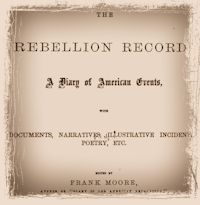April 21.—Major-General Peck issued the following general order at Newbern, N. C, this day: “With feelings of the deepest sorrow, the Commanding General announces the fall of Plymouth, N. C, and the capture of its gallant commander, Brigadier-General H. W. Wessells, and his command. This result, however, did not obtain until after the most gallant and determined resistance had been made. Five times the enemy stormed the lines of the General, and as many times were they handsomely repulsed with great slaughter, and but for the powerful assistance of the rebel iron-clad ram and the floating sharp-shooter battery, the Cotton Plant, Plymouth would still have been in our hands. For their noble defence, the gallant General Wessells and his brave band have and deserve the warmest thanks of the whole country, while all will sympathize with them in their misfortune.
“To the officers and men of the navy, the Commanding General renders his thanks for their hearty cooperation with the army, and the bravery, determination, and courage that marked their part of the unequal contest. With sorrow he records the death of the noble sailor and gallant patriot, Lieutenant Commander C. W. Flusser, United States navy, who in the heat of battle fell dead on the deck of his ship, with the lanyard of his gun in his hand.
“The Commanding General believes that these misfortunes will tend not to discourage the troops, but to nerve the army of North-Carolina to equal deeds of bravery and gallantry hereafter.
“Until further orders, the headquarters of the sub-district of the Albemarle will be at Roanoke Island. The command devolves upon Colonel D. W. Wardrop, of the Ninety-ninth New-York infantry.”
—The English schooner Laura was captured off Velasco, Texas, by the National gunboat Owasco.—As expedition in boats, from the gunboats Niphon and Fort Jackson, under command of Captain Breck, of the Niphon, proceeded to within seven miles of Wilmington, N. C, where they succeeded in destroying the North-Carolina salt-works and other property valued at over $100,000, and brought away fifty-five prisoners—laborers in the salt-works.



